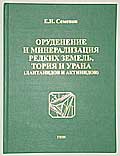Employed 1953 in new Institute of Mineralogy and Geochemistry of rare elements
(IMGRE), where works up to 1996) junior, senior research scientist and chief
of mineralogical laboratory (1965-1998), consultant.
Currently Premier research scientist at the Fersman Mineralogical Museum
RAS
D.Sc. 1963 in IGEM "Mineralogy, geochemistry and deposits of rare earths".
(RE=Ln,Y,Sc). Curator for REE in Ministry of Geology USSR, gave REE-programs
for 5-year plans and balances of REE in deposits of all republics of the former
USSR. Expert and consultant of the United Nations Development Program in India
(Madras 1968-1970; Raipur 1979-1982). Expert in international geological expeditions
in China (1958,1959), Greenland (1964,1982), Canada (1966,1978) Visited and
took part in mineralogical-geochemical study of many world-known rare-metal
deposits: Khibiny-Lovozero (Kola), Anabar (Yakutia), Aktijus (Kirgysia), Bayan
Obo (China), Ilimaussaq (Greenland), Saint-Hilair (Canada), Manavalacurichi
(India), Pocos da Caldas (Brazil) etc.
Described 50 new minerals in Russia, Tadjikistan, China, Canada, Greenland:
tundrite, darapiosite, huanghoite, lemoynite, ilimaussite etc - minerals of
nearly all rare metals: Li, Ba, Sr, Sc, Y, Ln, Zr, Th, U, Nb, Ta. Tundrite
which was found on Kola, is now known also in Greenland and Canada. Some of
those new minerals have economic importance: biotite and tugtupite as precious
stones, huanghoite and magbasite as raw materials (Ln, Sc, Nb). Found new
types of ores (chkalovite, epididymite - for beryllium, zircon without hafnium
etc). Discredited about 10 old minerals of other authors (angaralite, didymolite
etc). Expert in various mineralogical methods, especially optics. In the monograph
"System of minerals" (1991,1981) proposed new classification of' all known
minerals according to valence of main ion divided on his coordination number.
Showed importance of this number for selective or complex type of Ln-distribution
in RE-minerals. Demonstrated that not only yttrium and cerium REE-groups but
each of these 16 elements have their own minerals and types of ores. For instance,
aeschynite is neodimium (without Ca, Y) mineral of alkaline hydrothermalites.
Showed, that in case of low concentration of isomorphic pairs of elements
their ratio (Ce/Yb, Zr/Hf, Nb/Ta etc) is small. Gave classification of the
alkaline rocks according to activity of Na, K, Li, Ti and haloides (F, Cl)
in rock-forming biopyriboles - mainly amphibolous. With his leading participation
the list of Khibiny-Lovozero minerals is now approaching to 500 - twice more
that of any other deposit of the world. Under his guidance 10 geologists got
their Ph.D. and D.Sc. degrees. Gave courses of lectures on "Geology of rare
elements" and "Geology of alkaline massives and their deposits" in Moscow
University (1988, 1994), Kopsnhagen University (1993,1995), Toulousa University
(1995), Raipur University (1982). In Rio de Janeiro and San-Paulo (Brasil)
University (1995) 60-hours course "Minaralogy, geochemistry, crystal-chemistry,
oredeposits, economics and geoecology of rara elements" was given. Member
of the editorial bureau of magasine "Russian Geology", member of the council
of Mineralogical Society, membercorrespondent of the Russian Academy of Natural
Sciences. Published 18 books and 150 articles (first -in 1953) in Russian,
English, French, Chinese. Speaks English and reads French and German. Took
the most active part in 3-volume book of IMGRE "Geology, mineralogy and genetic
types of deposits of rare elamants" and received for that the USSR State Prise.
Received Fersman-prise of USSR Academy of Sciences for the study and discovery
many new minerals of alkaline massives. New RE-Be silicate -semenovite was
named in honor by Danish geologists. Plan of lectures of Prof. SEMENOV Evgeny
1. Geology of rare element deposits, especially in the former USSR (Types
of deposits, mineralogy, main features of geochemistry, ecology, prospecting
and evaluation) a) Rare alkalies (Li, Rb, Cs) b) Beryllium, strontium c) Rare
earths (Sc, Y, La-Lu) d) Zirconium, hafnium e) Niobium, tantalum f) Main features
of geology of chalcophylic elements (Cd, Hg, Ga, In, Tl, Ge, Sb, Bi, Se, Te)
2. Rare metal precious stones (Li, Be, RB, Zr, Ta) in Transbaikal, Urals,
Kola, Yakutia. 3. New ore deposits of Russia 4. Alcaline massives (especially
Lovozero, Khibiny on Rola) and their huge deposits of P, Nb, Ta, Zr, Y, La,
Al, Ga, K, Rb. 5. New minerals (more than 200) found in Russia and former
USSR and minerals for collections: a) Nepheline syenites (Lovozero, Khibina,
Murun in Aldan) b) Alkalic granites (Keyvy on Kola, Darapios in Tadjikistan)
c) Granite pegmatites (Kola, Altay, Transbaikal) d) Beryllium hydrothermalites
(Ermakovka in Burjatia) e) Borous salts and skarns (Urals, Burgatia, Inder
in Kazakhstan) f) Uranium hydrothermalites and their zone of oxidation (Streltsovka
in Transbaikal) g) Ptg-Ni-Cu sulfides (Norilsk on Taymyr) h) Volcanic exhalations
(Kamchatka, Kuril-islands) j) Carbonatites and their crust of weathering (Tomtor
in Jakutia)
 Издана
книга ведущего научного сотрудника Музея доктора геолого-минералогических наук
Семенова Е.И. Оруденение и минерализация редких земель,
тория и урана (лантанидов и актинидов). 307с., 44 илл., библиогр.
68 назв. , где впервые совместно рассматривается геология (преимущественно минералогия
и рудогенез) большой группы сходных элементов 3-го периода системы Менеделеева.
Издана
книга ведущего научного сотрудника Музея доктора геолого-минералогических наук
Семенова Е.И. Оруденение и минерализация редких земель,
тория и урана (лантанидов и актинидов). 307с., 44 илл., библиогр.
68 назв. , где впервые совместно рассматривается геология (преимущественно минералогия
и рудогенез) большой группы сходных элементов 3-го периода системы Менеделеева.